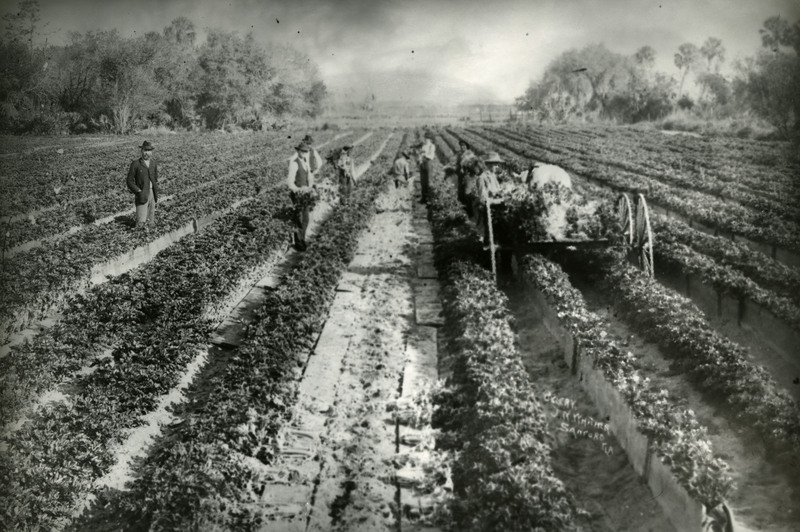J. N. Whitner's Celery Farm During Harvest Time
Dublin Core
Title
J. N. Whitner's Celery Farm During Harvest Time
Alternative Title
Mecca Hammock Farms
Subject
Photography--Florida-History
Agriculture--Florida
Celery industry
Celery
Sanford (Fla.)
Description
Mecca Hammock Farms during the harvest season in the 1890s . This celery farm was owned by J. N. Whitner and B. F. Whitner Sr. In 1897, the Whitners planted three-quarters of an acre with celery imported from Kalamazoo, Michigan.
Sanford was not always known as the "Celery City". The origins of Sanford's connection to celery farming began on December 26, 1894, when a freeze damaged the area's citrus groves. They began to recover during a warm and wet January which promoted new shoots, but a second freeze hit on February 7, 1895, practically wiping them out. The 24 degree temperature was the coldest known in Florida to that point. The freeze was so intense that the sap froze inside the trunks, many of which split open, sounding like gunshots, and crashed to the ground. The population quickly dropped from 5000 to 2000 as the groves were abandoned. I.H. Terwilliger stayed after the freezes and is believed to have planted the first celery grown in Sanford in 1896. By 1898, celery became the crop synonymous to Sanford.
Sanford was not always known as the "Celery City". The origins of Sanford's connection to celery farming began on December 26, 1894, when a freeze damaged the area's citrus groves. They began to recover during a warm and wet January which promoted new shoots, but a second freeze hit on February 7, 1895, practically wiping them out. The 24 degree temperature was the coldest known in Florida to that point. The freeze was so intense that the sap froze inside the trunks, many of which split open, sounding like gunshots, and crashed to the ground. The population quickly dropped from 5000 to 2000 as the groves were abandoned. I.H. Terwilliger stayed after the freezes and is believed to have planted the first celery grown in Sanford in 1896. By 1898, celery became the crop synonymous to Sanford.
Creator
Ensminger, Jefferson Clay
Source
Reproduction of glass plate negative by Jefferson Clay Ensminger: Photographic Collection, box 3, folder Ensminger, General Collection, UCF Public History Center, Sanford, Florida.
Date Created
ca. 1890-1899
Has Format
Original glass plate negative by Jefferson Clay Ensminger.
Is Format Of
Digital reproduction of reproduced glass plate negative by Jefferson Clay Ensminger.
Is Part Of
Photographic Collection, box 3, folder Ensminger, General Collection, UCF Public History Center, Sanford, Florida.
General Photographic Collection, Student Museum and UCF Public History Center Collection, Sanford Collection, Seminole County Collection, RICHES of Central Florida.
Is Referenced By
"The Celery City: Second Edition." The Sanford Herald, November 25, Industrial section, Sanford yesterday/Sanford tomorrow edition.
Format
image/jpeg
Extent
2.3 MB
Medium
1 glass plate negative
Language
eng
Type
Still Image
Coverage
Sanford, Florida
Spatial Coverage
28.799105, -81.255802
Temporal Coverage
1890-01-01/1899-12-31
Accrual Method
Donation
Mediator
History Teacher
Economics Teacher
Geography Teacher
Provenance
Originally created and owned by Jefferson Clay Ensminger.
Rights Holder
Copyright to this resource is held by the Student Museum and is provided here by RICHES of Central Florida for educational purposes only.
Contributing Project
Curator
Morton, Dave
Digital Collection
Source Repository
External Reference
Mills, Jerry W., and F. Blair Reeves. A Chronology of the Development of the City of Sanford, Florida: With Major Emphasis on Early Growth. S.l: s.n.], 1975.
Still Image Item Type Metadata
Original Format
1 glass plate negative
Collection
Citation
Ensminger, Jefferson Clay, “J. N. Whitner's Celery Farm During Harvest Time,” RICHES, accessed December 24, 2025, https://richesmi.cah.ucf.edu/omeka/items/show/855.
